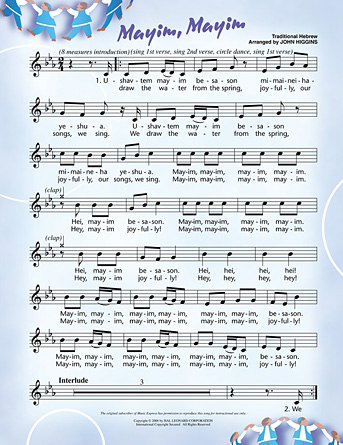*2nd Generation dance. A dance that developed and was disseminated in a non-traditional way. 2G dances are specific – have a fixed format designed to correspond with the arrangement of a particular recording., whereas 1G dances are generic – have a shorter sequence that works with live music – where many different songs are played and arrangements vary according to the tastes of musicians and dancers. For more on the differences between 1st & 2nd G dances click here.
In the early years of the 20th Century, the trickle of Jews returning to settle in the “promised land” around Jerusalem became a steady stream. Until about 1918 the land was a small part of the Ottoman Empire, with no defined borders; by 1920 the British had taken control of a territory they called Palestine. It was inhabited by a majority Moslem population, and a growing and increasingly aggressive Jewish population determined to create a sovereign state.
A hallmark of Jewish settlement in Palestine was the kibbutz – a plot of collectively-owned land organized as a utopian agricultural community. Each kibbutz consisted of a unique blend of socialists, Zionists, and secularists – some conservative, many radical. Surrounded by often-hostile Arab neighbours, most kibbutzim aimed for self-sufficiency. Frequent group meetings featured not only discussions of economics, agriculture, and politics, but also social and artistic interests. Often a meeting would start with a group dance created on the kibbutz. By the mid-1930’s, kibbutzim began creating festivals celebrating agricultural holidays, co-ordinating celebrations with other kibbutzim, and sharing dances with each other. In 1944 Gurit Kadman, (considered the “impulse and continuing inspiration for the entire folk dance movement in Israel”*) organized the first Palestine-wide dance festival at Kibbutz Dalia. One of its featured dances was Mayim, Mayim.
The origins of Mayim, Mayim are controversial. It is agreed the music was composed by Emanuel Pugachov (later known as Emanuel Amiran), set to the words of Isaiah 12:3.

Gurit Kadman was the first to publish Mayim, Mayim, (in the program notes for the 1st Dalia Festival, 1944) and she claimed its creators were anonymous. She was eager to prove the dances of that era in Palestine were legitimate folk dances, springing spontaneously from the people.
However Else Dublon claims she choreographed the dance in 1937. Else Dublon had arrived from Germany and joined Kibbutz Yagur in 1936. There she met the composer Yehuda Sharett and with him prepared several kibbutz festivities. In 1937 Sharett was asked to device a “Water Pagaent” for Kibbutz Na’an, where a new deep well had been bored, the newly found source of water making the existence of the kibbutz farm a viable venture. Yehuda took Else with him to Na’an. In an interview she stated: ” … Yehuda gave me his song “Usha’avtem”, which he had orchestrated, and I made it into a whole ceremony. My dance began with a step which I felt expressed waves (of water). The next part, in which the dancers entered the circle, expressed the flowing of the water from the well. The third part of what became a folk dance, with its jumps, is not my creation. (In my own version) there were no jumps. As I was choreographing for untrained dancers, I had to devise simple steps, but I didn’t wish to have them just doing Hora-steps. This dance was done by several circles of dances, one inside the other … ” (This information was recorded by Shalom Hermon for the “Israel Dance Documentation Project”.) *
Saiya Ben Ya’acov claims that she added on to Dublon’s dance, thus taking credit for the final version. **
Another contender for Mayim, Mayim’s creation stems from a recollection by famed choreographer Yoav Ashriel: “I remember when I was 13 or 14 (1943 or 44) my teacher told me water had been found in Kibbutz Beit Ha-shita near the Gilboa Mountain. The kibbutz children’s teacher, named Shaiya, had taken her classes to the site and choreographed them running around the well. We heard it was a very beautiful celebration and the story made a big impression me.”**
Today Dublin generally gets the credit for Mayim, Mayim’s choreography.
As for the “meaning” of the dance, its various movements have suggested to some imaginations water splashing against shorelines or dams, irrigation sprinklers, joy at finding water, religious thanksgiving, etc. Kadman denies any religious significance to the dance. Else Dublon described her choreography above.
Nevertheless Mayim, Mayim is THE classic Palestinian/Israeli dance. Although many dances were created before Mayim, Mayim, (the first was Hora Agadati, in 1924) it is the earliest Palestinian dance that is still popular today. The grapevine step featured in the choreography is known by many Israelis as the Mayim step, as the figure became known to Israelis through this dance.

Sources:
*THE DEVELOPMENT OF FOLK DANCE IN ISRAEL By Dr. Zvi Friedhaber
**from Seeing Israeli and Jewish Dance by Judith Brin Ingber. c.2011 Wayne State University Press. p.104, 108, 166
Folk Dance Problem Solver, 2001 edition. Available from the Society of Folk Dance Historians SFDHist@gmail.com
Wikipedia
